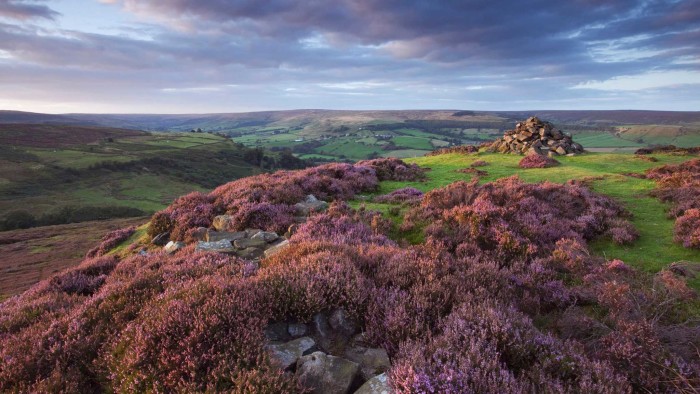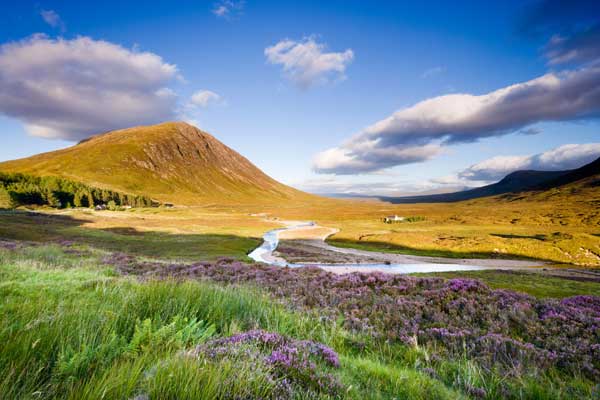Landscape: moor surprises – from rare birds to carnivorous plants

Simply sign up to the Life & Arts myFT Digest -- delivered directly to your inbox.
Upland heath is a landscape of contradictions. The literary and cinematic world have long revelled in their dark side: the blasted, barren heath immortalised in Wuthering Heights, the murderous moor of The Hound of the Baskervilles, and the pitch black terror of An American Werewolf in London. Travel through moorland by car with the windows up and – unless you’re really looking – you might struggle to see or hear a living thing, apart from the nonchalant ambling of the odd sheep. And the reputation for climatic calamity is not without merit either; get caught on a heath in a thunderstorm or hill mist and you’ll wish you hadn’t.
It is certainly true that these are singular places with vast landscapes of steep hills and mountains interspersed with broad plains, exposed to the elements and where vegetation – often no more than knee-high for miles – offers no protection from wind, rain or sun. But they are far from barren. In summertime the dominant plant species of many upland heaths – the heathers – turn mile upon mile of moor dusky purple; a huge undulating bruise across the countryside and one of the most memorable landscape scenes in the world. The wide open spaces are home to flora and fauna found nowhere else including rare and vulnerable “red list” species, birds such as the fast flying, dragonfly-eating merlin, and mammals like the timid mountain hare. They are particularly important for invertebrates; at least 40 species of insect feed on nothing but heather.

Upland heath is an ecological environment confined to the British Isles and the western seaboard of Europe. A significant proportion – about three-quarters – is in Britain, roughly 3m hectares, the vast majority of which is in Scotland. In England, the Northumberland National Park and North York Moors National Park contain particularly large areas of upland heath, with Dartmoor and Exmoor in the southwest, the Peak District, and the North Pennines home to slightly smaller but still significant moors.
Found at altitudes of between 250m and 750m above sea level, upland heath is characterised by low-growing vegetation and dwarf shrubs including ling (Calluna vulgaris), bell heather (Erica cinerea), cross-leaved heath (Erica tetralix), bilberry (Vaccinium myrtillus), crowberry (Empetrum nigrum) and juniper (Juniperus communis). These shrubs have adapted to grow in the shallow peat and mineral soils that typify moorland, and to tolerate the high levels of exposure. Soils can be dry and fast draining, typical of moors at southerly latitudes, or wet and boggy, found more frequently in the north and west. Deer grass (Scirpus cespitosus) and purple moor-grass (Molinia caerulea) are endemic to wet moors along with the heather, growing over an under layer of mosses.

It is the heather plants that give upland heaths their transformative appearance in summer when in flower, but it is the maintenance regime applied to the heather that keeps the moorland as moorland. The climax vegetation of the British Isles is deciduous woodland, and any area of open ground left untended for even a short period of time will slowly revert; short grass and meadow turning into tussock grass before seedling trees and shrubs appear, pioneer species such as birch, pine and hazel moving in to take control. Within a decade or two a young wood will be firmly established, 20 years later no trace of the open land will be left. Without human intervention there would be no upland heath.
For centuries hill farmers have used heaths for grazing breeds of hardy, self-sufficient sheep. These are as much part of the moorland ecology as the native plant and animal species. Some breeds, in particular the Swaledale sheep, have become synonymous with the moors. The sheep graze the soft, fresh tips of the heather but these are slim pickings compared with lowland pasture, and the density of sheep reflects this.
Making a living from hill farming has always been tough; the line between sustainable grazing and destructive overgrazing razor-thin, and where overgrazing has taken place it has been a contributory factor in the decline of moorland.

Land reclamation has also degraded upland heath – during the 1950s and 1960s landowners were encouraged to drain marginal land, including moorland, through a subsidy scheme – as has forestation, again encouraged through subsidies and tax loopholes. It is easy to see the appeal of schemes that gave purpose and income to large areas of land that were otherwise unproductive apart from low intensity grazing. But the impact of them, along with overgrazing, poor management (leading to domination by invasive species such as bracken) and uncontrolled burning have all contributed to a declining picture. About 20 per cent of moorland was lost in England and Wales between 1947 and 1980, and the downgrading and fragmentation of heaths across the British Isles continues.

Upland heath is important for a range of nationally and internationally rare birds, including twite, hen harrier, merlin, and ring ouzel. It is the presence of red grouse and the rarer black grouse and management of moorland for shooting that have arguably been the saviour of upland heath, but not without controversy and tension between landowners and conservationists. It can be hard to spot grouse on a moor at first, but once your eye is in there they are; perched in the top of the heather or on top of a dry stone wall, surveying the heath with a quizzical look. Black grouse are responsible for a unique courtship spectacle known as lekking, where groups of birds gather at dawn, displaying their plumage, calling loudly and generally showing off.
Grouse feed on the same soft young heather growth that sheep enjoy, so a healthy population of grouse need healthy heather. The nutritional value of heather declines with age as the plants become woody and the amount of foliage reduces, so moor keepers use controlled burning to encourage regeneration. This involves setting fire to small areas on a rotational cycle that can vary from seven years to 25 years depending on the soil conditions and subsequent vigour of the heath. There are strict guidelines on when moors should be burnt to ensure the timing is outside the main breeding season of ground-nesting birds, including, of course, the money-spinning grouse.

Whichever way you cut it, the effort and energy put into maintaining upland heath in the best possible health comes at the price of one of the principle beneficiaries being shot once the “Glorious Twelfth” comes around each August. The grouse-shooting industry is worth about £70m in England alone, supports 1,500 jobs and brings in valuable tourism. Conservationists point out that overzealous gamekeeping results in the persecution of rare and threatened predatory birds such as the hen harrier – which will take young grouse – and mammals that eat birds’ eggs, like stoats and weasels. Landowners use the counter argument that without the shoot, there wouldn’t be a moor. Conservationists claim that landowners are taking a pick-and-mix approach to species conservation. National parks authorities seem to take a conciliatory middle ground.
In among the controversy, the heathers and the creatures that live on the moorland, there is, to my mind, the most beautifully strange plant if you are lucky enough to find it: the round-leaved sundew (Drossera rotundifolia). Growing in wet and boggy peat, the tiny, delicate sundew has evolved carnivorous habits to supplement the lack of nutrients available from the heath. Its red, pad-like leaves are equipped with tendrils that glisten with what appears to be dew. But the dew is deadly; as sticky as glue, insects are attracted to it, then adhered before the leaf curls around its prey in a excruciatingly slow, fatal embrace. Carnivorous plants seem so exotic that to find them growing in places like Yorkshire and Northumberland always comes as a surprise, but then there are few landscapes more surprising than upland moor.
Matthew Wilson is managing director of Clifton Nurseries in London
Comments